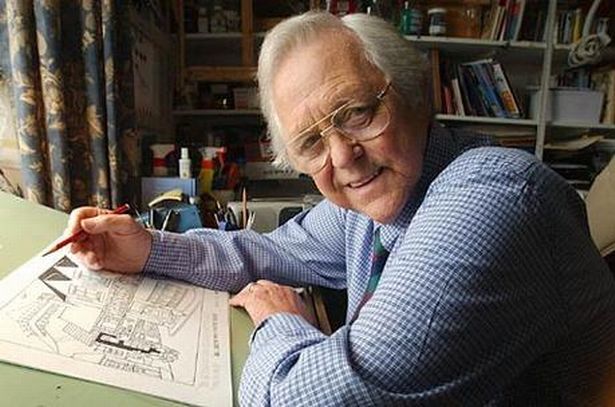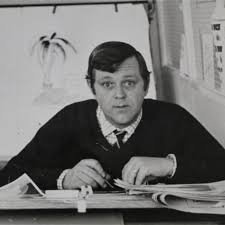Gren

GRENFELL JONES MBE, but better known simply as ‘Gren’, produced a daily cartoon for the South Wales Echo for over 29 years. These cartoons won him numerous awards – including Provincial Cartoonist of the Year four times – while making him a household name in Wales.
But his influence extends far beyond the borders of his native land, with a succession of sporting calendars, rugby, golf and cricket artwork earning him international acclaim. He produced 24 books and illustrated many others – including Max Boyce’s best seller I Was There.
For his charitable work, Gren was honoured by the Variety Club of Great Britain and, in 1991, he was awarded the MBE for his services to the newspaper industry. He was given an honorary degree by the University of Glamorgan in 2004.
While living in Cardiff he insisted it was really just a holiday home; his heart remained in Hengoed, with a view of the famous viaduct that features in so many of his works.
As resident cartoonist of the Echo and creator of Aberflyarff RFC, Gren was an institution, thanks to his images of valley life and humour.
He was also a fast worker: after a morning discussion with the paper’s editor, his cartoons were drawn and ready to go by 9.50am – always topical and funny, they were never offensive. In 1999, after three decades of drawing a cartoon every day, he retired.
But Gren confessed in 2004, “I’m just as thrilled if I see a cartoon of mine in print today as I was 30 years ago.”

Having started as a boy drawing caricatures of neighbours and local people in his hymn book at his local chapel in Hengoed, Gren soon started sending pictures to agents, desperate to earn a living from his obsession with drawing. Later, he scribbled in lay-bys, when he should have been selling tiles and machine tools as a travelling rep.
“All I ever wanted was to draw,” he said. “I have an almost childish love of cartoons. I always look forward to doing them. If it wasn’t my work, I’d be doing them as a hobby.”
To this day, Gren’s cartoons remain instantly recognisable for their style, wit and commentary on daily life.
He was voted best provincial cartoonist in Britain four times in five years during the 1980s, his calendars hang on office walls from Pontlottyn to Patagonia, Senghenydd to Singapore, and locals and ex-pats alike scramble for his diaries and books.
“When I first started I spent a lot of time with Jon, of the Daily Mail,” he recalled. “He said draw what you know. And I knew about rugby and the valleys.”
Those two subjects sparked off the magic world of Gren, of Nigel and Neville, his famous message-bearing sheep – ‘Ban Mint Sauce’ and ‘Eat More Beef’ were ones that stick in the memory – and the fictitious village of Aberflyarff, with its tightly-packed terraced streets, so real you expect to see it signposted once you get past Porth.
Ponty, Pop, Bromide Lil and the other characters who live there have become part of Welsh folklore, but Gren was equally adept at the daily job of putting his own insightful comic slant on the latest happenings in the real world.
One of Gren’s favourites was the cartoon he did when Charles and Diana married in 1981. His humour did occasionally land him in hot water over the years, with one or two bad-taste jokes finding their way into the paper and provoking storms of protest.

Gren Jones was born on June 13, 1934, the son of Harry Jones, a collier. At the age of eight he began drawing pocket cartoons in the style of Ronald Niebour (‘Neb’) of the Daily Mail, recalling later: “Neb was responsible for my first interest in cartoons. I used to go to my grandmother’s, who would have the Daily Mail, and I was amazed how the cartoonist could do a different drawing every day.”
Jones’s first published drawing was a joke cartoon for Spick & Span, and afterwards he sold his first news-related cartoon to the Birmingham Mail.
In 1960, Jones became one of the founder members of the Knights Of The Round Table, a pop group that would later transform itself into the successful satirical group the Barron Knights.
From 1958 to 1963 Jones was employed as an engineering designer. For a number of years he worked as a freelance cartoonist before, in 1968, getting a staff job with the Western Mail and Echo.

It was the dawn of the ‘golden era’ of Welsh rugby and a time when the papers had big circulations. “Before I became editor of the South Wales Echo Gren’s work was being used as a single column,” said Geoff Rich, who worked alongside the cartoonist for 19 years.
“On my first day in charge I splashed him across five columns. He was simply that good and became increasingly important to the paper. He was an incredible observer of the ordinary man and he was the sheer epitome of south Wales. Even people who had never met him felt they knew him so well through his work.”
At Thomson House, he produced a daily topical cartoon, but was perhaps best known for creating the strip ‘Ponty an’ Pop’ in the South Wales Echo and Saturday’s Football Echo, featuring the village of Aberflyarff in Scrumcap Valley on the River Efflew, with colourful characters such as Ponty and Pop themselves and, of course, Bromide Lil, the tattooed barmaid of the Golden Dap… apparently, she was only ever unfaithful twice – to a male voice choir on tour and Aberflyarff Seconds when they won their league!
His strip ‘Big Deal’ was syndicated for 35 years, and he has also produced many sporting calendars, as well as some with a business theme – notably for Bemrose Publishers for 20 years. He was official ‘war artist’ for the Welsh Rugby Union and also drew cartoons for Wales on Sunday.
Signing himself ‘Gren’, or sometimes ‘Jones’, he preferred to work in line and wash. He retired in 1999 on his 65th birthday, recalling afterwards that he had enjoyed working as a newspaper cartoonist: “I considered it a job but I enjoyed the adrenalin of working to deadlines.” Gren continued to produce cartoons for the Echo evening paper from home.
Owning an ‘original Gren’ was an honour and appearing in one an even greater honour, which his friends Max Boyce, Harry Secombe and Wyn Calvin all did.
His popularity gave him other opportunities, including drawing the cover for the Boyce’s album We All Had Doctors’ Papers…, and resultantly became the first cartoonist to receive a gold disc from the record company EMI.

Through his career he produced over 24 books; while for charity he produced his annual rugby calendar as well as selling numerous original sketches.
Gren, who lived in the Llandaff area of Cardiff, died aged 72 at the city’s University Hospital of Wales on Thursday, January 4, 2007. Married to Anne, the couple had two sons who both became policemen. At the time of Gren’s death, he had four grandchildren.
Gren continued to work to the end, with his constant friend and pal at his side; Charlie Friday of Llandaff – a Cocker Spaniel.
Fellow cartoonist Bill Tidy paid this tribute: “I was a great admirer of Gren. To me, he was a Max Boyce on paper and a Harry Secombe in humour. He raised a large amount of money for charity, he was crazy on rugby and was the only Welshman I’d ever met who sang out of tune deliberately. He had his finger on the pulse of Wales.”
Former First Minister Rhodri Morgan also paid tribute to the award-winning cartoonist, saying: “Gren’s cartoons were always funny, and that’s the number one job of a cartoonist – to put something that’s funny into a well-drawn cartoon – and Gren could do that like nobody else.
“We’re all much the sadder for his passing. There’s never been another chronicler of the post-industrial age arriving and the industrial age declining like Gren.”
And he added that he never minded appearing in a Gren cartoon. “It is a great honour – to be lampooned by Gren means that you have arrived as a politician.”
The Welsh Rugby Union thanked Gren for helping to immortalise “the great Welsh players of the Seventies”.

“Welsh rugby has lost a great friend,” said WRU group chief executive Roger Lewis. “For almost 40 years he lit up the lives of Welsh people around the world with his fantastic grip on Welsh life and humour. Who can ever forget the village of Aberflyarff, Bromide Lil and Attila Groinstomper?”
As the greatest Welsh rugby player of the 1970s, Gareth Edwards, put it: “He defined our character and he never failed to raise a smile.”
In Gren’s obituary for the Daily Telegraph, rugby writer Brendan Gallagher noted: “Gareth and Gerald scored the tries; Barry and Phil kicked the goals; Pricey and JPR sorted out the nutters; Max sang the songs and wrote the ditties; JBG penned the reports; but it was Gren who topped the lot by drawing the cartoons that made a country laugh – again and again and again.
“Modest to a fault, he would be shocked and a little amused to hear that many believe he did more to define ‘Welshness’ and celebrate Wales’s individuality than any figure in the 20th Century. A big claim, but only Dylan Thomas really runs him close.”

The Jester, newsletter of the Cartoonists’ Club of Great Britain, in succinct style, described Gren as “the undisputed Godfather of the Taffia”.
The Gren Way walking route was officially launched in Hengoed in September 2010. Caerphilly County Borough Council was keen to commemorate Gren’s life and work by creating a unique ‘Gren Way’ walking route in and around Hengoed – the village of his birth – the route crossing the imposing viaduct that spans the valley between Hengoed and Maesycwmmer.
In 2013, Gren’s son Darryl Jones helped create a continental-style bottled beer in his father’s honour. Rhymney Brewery sent out 10,000 bottles of the new brew ‘Gren’ – made with a New Zealand hop – to retailers, including the Wales Millennium Centre in Cardiff.

A Gren drawing of a sheep bearing the logo ‘Keep Wales Tidy’ was also used to front an anti-litter campaign in Wales.
A tribute to Gren’s work is sculpted in iron at the front of the Media Wales office next to the Millennium Stadium.
References include The Jester, South Wales Echo, Media Wales, BBC Wales, Daily Telegraph.
BACK TO HOME PAGE